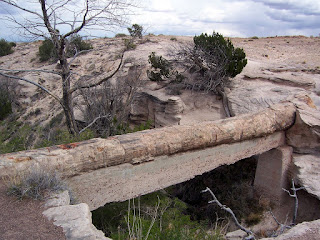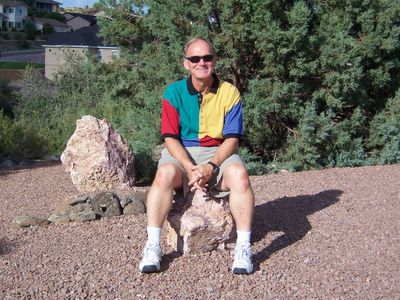The Petrified Forest & The Painted Desert

250,000 years ago Arizona lay near the Equator in a tropical environment. Tall conifer trees grew along rivers. Small dinosaurs lived there with crocodile-like creatures and giant amphipians. Trees fell and were carried away by rivers and buried in silt and volcanic ash. Mud cut off the oxygen and slowed their decay. Silica seeped into the wood and replaced the tissue. It crystallized into quartz petrifying the trees.


Here a petrified log has been cut and polished. Because visitors are keen on having pieces of petrified wood, there are heavy fines for removing them. Many places sell them legally outside the park.
 The Agate Bridge. Centuries of erosion of softer surrounding sandstone left this petrified tree a natural bridge. In 1906 conservationists built a support under it. Today's philosophy would leave it as it was and allow nature to takes its course.
The Agate Bridge. Centuries of erosion of softer surrounding sandstone left this petrified tree a natural bridge. In 1906 conservationists built a support under it. Today's philosophy would leave it as it was and allow nature to takes its course.Hey, just wanted everyone to know the new diet plan is working great!
Actually this is Placerias, a large plant-eating Triassic Era critter, who roamed Arizona back when these trees were alive and well. His skeleton was found in the Park.
This formation is called The Tepees. These cone shapes get their color from iron, carbon, manganese and other minerals.

Wouldn't it be interesting to know what the first Native Americans thought of the area? We know they used the materials to build houses here 800 years ago. This is the Agate House.
 Another indication of habitation of the area is the many petroglyphs. Hundreds are etched in the stone known as Newspaper Rock. (For a closer view, click on the picture.)
Another indication of habitation of the area is the many petroglyphs. Hundreds are etched in the stone known as Newspaper Rock. (For a closer view, click on the picture.)
At the north end of the Park you arrive at the Painted Desert. It is an expanse of arid and eroded land 160 miles long which extends from the Grand Canyon to the Petrified Forest.

The rainbow colors come from exposed sedimentary layers that contain various mineral deposits. It is a gorgeous austere landscape.






0 Comments:
Post a Comment
<< Home